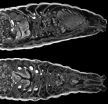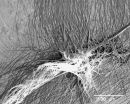(Press-News.org) CINCINNATI—About one in seven men will develop prostate cancer over the course of a lifetime, and about one in 36 men will die from it.
This is why findings by Cincinnati Cancer Center researchers, showing that a tumor suppressive microRNA, when activated by an anti-estrogen drug, could contribute to development of future targeted therapies, are important.
These findings are published in the May 16, 2014 edition of the journal PLOS ONE.
"MicroRNAs, or miRNAs, are short RNA molecules that play a prominent role in regulating gene expression. One miRNA can target multiple genes, but their expression is often hijacked by cancer cells and disrupts multiple cancer-causing or tumor-suppressing pathways," says Shuk-Mei Ho, PhD, director of the CCC and Jacob G. Schmidlapp Chair of Environmental Health and professor at the University of Cincinnati (UC) College of Medicine.
She along with Ricky Y.K. Leung, PhD, member of the CCC, assistant research professor in the department of environmental health and member of the UC Cancer Institute, and their team identified a new miRNA, known as hsa-miR-765, which is specifically activated by a Food and Drug Administration (FDA)-approved anti-estrogen drug (fulvestrant).
"This miRNA suppresses expression of HMGA1, a gene that was shown in previous studies to be associated with prostate cancer progression and recurrence," says Leung. "These findings do not only contribute to new insights on the effects of anti-estrogen but also the potential of using miRNA for monitoring drug efficacy and for future RNA-based therapy developments.
"This study also highlights the potential use of this anti-estrogen or miRNA in patients with recurrent prostate cancer, for whom there is no treatment, and raises the possibility of using anti-estrogen or miRNA treatments in preventing or slowing progression for primary prostate cancer."
Using cultured prostate cancer specimens from patients who were given a single 250 mg dose of fulvestrant, researchers found that hsa-miR-765 acted as a tumor suppressor when its expression was increased by the use of fulvestrant.
"Both the anti-estrogen and the hsa-miR-765 mimic suppressed HMGA1 protein expression," Ho says. "Levels of hsa-miR-765 were increased, and HMGA1 expression was almost completely lost in prostate cancer specimens from patients treated with a single dose of fulvestrant 28 days before removal of their prostate glands.
"These findings reveal a unique fulvestrant signaling process involving the increased regulation of hsa-miR-765 that suppresses the HMGA1 protein as part of the mechanism underlying the tumor suppressor action in prostate cancer. This could lead to newer treatment options with less toxicity for these patients."
INFORMATION:
This research, which was conducted with collaborators from the University of Pittsburgh, was funded by the Hong Kong University Grant Council-General Research Fund (M469107), Chinese University of Hong Kong Direct Research Grants (CU2041252 and CU2041563) a VA Merit Award (I01BX000675), National Institutes of Health grants (ES019480, ES020956, ES015584, ES006096, CA112570, CA015776) and a grant from the Investigator-sponsored Study Program of AstraZeneca. UC researchers cite no conflict of interest.
The content is solely the responsibility of the authors and does not necessarily represent the official views of the National Institutes of Health.
The University of Cincinnati, Cincinnati Children's Hospital Medical Center and UC Health have created the Cincinnati Cancer Center—a joint effort designed to leverage the strengths of all three organizations in order to provide the best possible cancer diagnostics, research, treatment, and care for individuals in the Tristate region and the nation. To learn more, visit cincinnaticancercenter.org.
MicroRNA that could be used to suppress prostate cancer progression found
2014-05-17
ELSE PRESS RELEASES FROM THIS DATE:
Breakthrough in HIV/AIDS research gives hope for improved drug therapy
2014-05-17
PITTSBURGH, May 16, 2014 – The first direct proof of a long-suspected cause of multiple HIV-related health complications was recently obtained by a team led by the University of Pittsburgh Center for Vaccine Research (CVR). The finding supports complementary therapies to antiretroviral drugs to significantly slow HIV progression.
The study, which will be published in the June issue of the Journal of Clinical Investigation and is available online, found that a drug commonly given to patients receiving kidney dialysis significantly diminishes the levels of bacteria that ...
Transgenic mice produce both omega-3 and omega-6 fatty acids on carbohydrate diet
2014-05-17
Massachusetts General Hospital (MGH) investigators have developed a transgenic mouse that synthesizes both the omega-3 and omega-6 essential fatty acids within its tissues on a diet of carbohydrates or saturated fats. Called "essential" because they are necessary to maintain important bodily functions, omega fatty acids cannot naturally be synthesized by mammals and therefore must be acquired by diet. Significant evidence suggest that the ratio of dietary omega-6 to omega-3 has important implications for human health, further increasing interest in the development of ...
Gender differences stand out in measuring impact of Viagra as therapy for heart failure
2014-05-17
New animal studies by Johns Hopkins cardiovascular researchers strongly suggest that sildenafil, the erectile dysfunction drug sold as Viagra and now under consideration as a treatment for heart failure, affects males and females very differently.
The results of their investigations in varied male and female mouse models of heart failure are so clear-cut, says lead scientist Eiki Takimoto, M.D., Ph.D., that physicians may need to take gender into consideration when prescribing certain medications and that drug developers would be wise to take them into careful account ...
The early earthworm catches on to full data release
2014-05-17
To quote the American cartoonist Gary Larson: all things play a role in nature, even the lowly worm—but perhaps never in such a visually stunning way as that presented in two papers published today in the open access journals GigaScience and PLOS ONE. The work and data presented here provide the first-ever comparative study of earthworm morphology and anatomy using a 3D non-invasive imaging technique called micro-computed tomography (or microCT), which digitizes worm structures. This opens the possibility of scanning millions of specimens from museum collections, including ...
JCI online ahead of print table of contents for May 16, 2014
2014-05-16
Targeting microbial translocation attenuates SIV-mediated inflammation
Patients with HIV often present with signs of immune activation and systemic inflammation, both of which are hypothesized to directly contribute to the development of AIDs in infected individuals. HIV and the related simian immunodeficiency virus (SIV) damage the gut mucosa, leading to translocation of microbes from the intestinal lumen to the general circulation, but it is not clear if microbial translocation is directly responsible for chronic HIV-associated inflammation. In this issue of the Journal ...
Methadone programs can be key in educating, treating HCV patients
2014-05-16
BUFFALO, N.Y. – People who inject drugs and are enrolled in a drug treatment program are receptive to education about, and treatment for, hepatitis C virus, according to a study by researchers at several institutions, including the University at Buffalo.
That finding, published online this week in the Journal of Addiction Medicine will be welcome news to health care providers. The paper notes that injection drug use is a primary mode of infection, making for an HCV infection prevalence as high as 80 percent among people who inject drugs.
"One of the most important findings ...
Non-invasive lithotripsy leads to more treatment for kidney stones
2014-05-16
DURHAM, N.C. – When it comes to treating kidney stones, less invasive may not always be better, according to new research from Duke Medicine.
In a direct comparison of shock wave lithotripsy vs. ureteroscopy – the two predominant methods of removing kidney stones – researchers found that ureteroscopy resulted in fewer repeat treatments.
The findings were published May 16, 2014, in the journal JAMA Surgery, coinciding with presentation at the annual meeting of the American Urological Association.
"Nearly one out of 11 people in the United States has kidney stones, ...
Cognitive behavioral or relaxation training helps women reduce distress during breast cancer treatment
2014-05-16
Coral Gables, Fla. (May 16, 2014) – Can psychological intervention help women adapt to the stresses of breast cancer? It appears that a brief, five-week psychological intervention can have beneficial effects for women who are dealing with the stresses of breast cancer diagnosis and surgery. Intervening during this early period after surgery may reduce women's distress and providing cognitive or relaxation skills for stress management to help them adapt to treatment.
Researchers at the University of Miami recruited 183 breast cancer patients from surgical oncology clinics ...
Spiders spin possible solution to 'sticky' problems
2014-05-16
Researchers at The University of Akron are again spinning inspiration from spider silk—this time to create more efficient and stronger commercial and biomedical adhesives that could, for example, potentially attach tendons to bones or bind fractures.
The Akron scientists created synthetic duplicates of the super-sticky, silk "attachment discs" that spiders use to attach their webs to surfaces. These discs are created when spiders pin down an underlying thread of silk with additional threads, like stiches or staples, explains Ali Dhinojwala, UA's H. A. Morton professor ...
With imprecise chips to the artificial brain
2014-05-16
This news release is available in German. Which circuits and chips are suitable for building artificial brains using the least possible amount of power? This is the question that Junior Professor Dr. Elisabetta Chicca from the Center of Excellence Cognitive Interaction Technology (CITEC) has been investigating in collaboration with colleagues from Italy and Switzerland.
Their surprising finding: Constructions that use not only digital but also analog compact and imprecise circuits are more suitable for building artificial nervous systems, rather than arrangements ...



